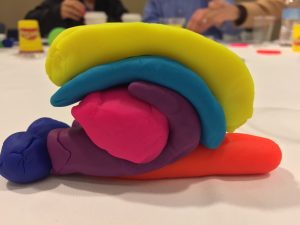One Sided Conflict Resolution
This was the title that caught my eye – how can you resolve a conflict with someone else without actually engaging that person? At least, that’s what I thought when I signed up for this pre-conference workshop at the recent International Ombudsman Association annual meeting. I was also intrigued by the presenter – Nicole Gravagna, PhD – who has a background as a neuroscientist and in the venture capital world (she wrote “Venture Capital for Dummies”).
So, what’s this all about and how can it help me in my work as the NC State Faculty & Staff Ombuds? I will not provide all the details of the session yet its worth mentioning that we started out by shaping Playdo into parts of our brain with a focus on the ACC  – Anterior Cingulate Cortex. (can you identify these parts of the brain? Hint: brain stem – corpus callosum – amygdala – hippocampus – thalamus)
– Anterior Cingulate Cortex. (can you identify these parts of the brain? Hint: brain stem – corpus callosum – amygdala – hippocampus – thalamus)
Gravagna explained that based on neuroscience understanding, the ACC activates in the presence of conflict, when making decisions under uncertainty, when feeling social exclusion, and when feeling physical and emotional pain. Thus, the stronger your ACC the better you are able to observe and consider how to respond. With a stronger ACC you are more able to make choices and be more resilient.
The idea is that you can resolve (or perhaps at least better manage) conflicts from one side – your side. You accomplish this by responding differently to the situation and by making informed decisions as opposed to reacting in the moment, According to Gravagna, you strengthen the ACC through “noticing” activities like meditation that taps into two of three brain inputs – sensation, emotion, and thought. When you sense something and think about it you notice in a way that strengthens your ACC.
With this in mind (pun intended), part of the message I now share with people coming to the ombuds office is that they can take “one sided” steps to address the situation. We identify and discuss the underlying concerns and interests that are important to the person and then try to identify options within the person’s control that could impact the situation. One sided conflict resolution indeed!
So, the next time you are in a conflict situation – you might want to think – what can I do on my own? And, if you want to learn more about the ACC, then check out Gravagna’s recent book – “Mindset your Manners: Master Conflict and Change the Rules.”
- Categories: